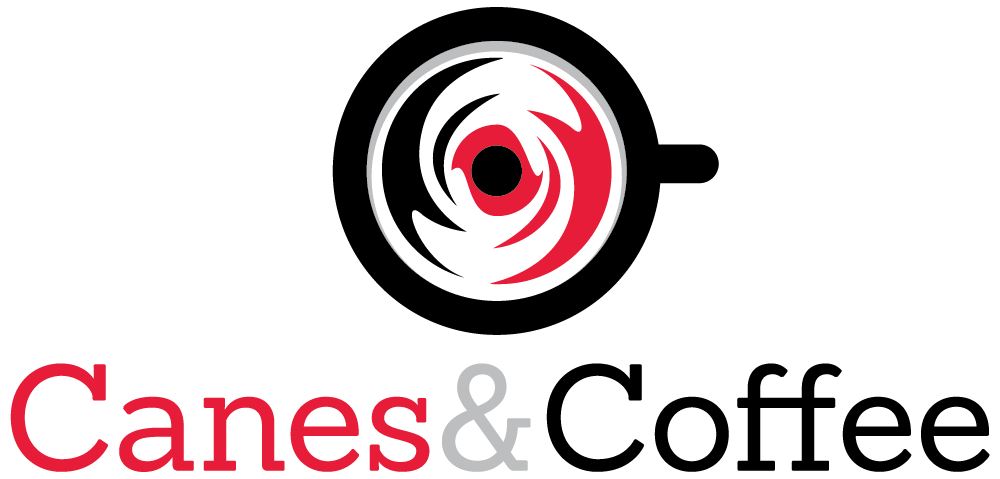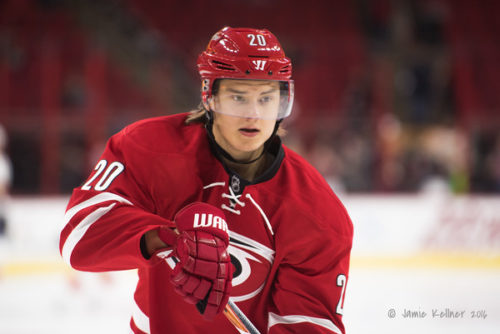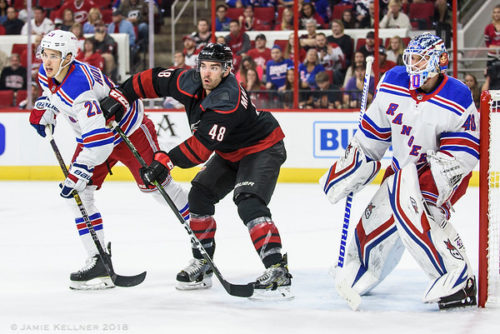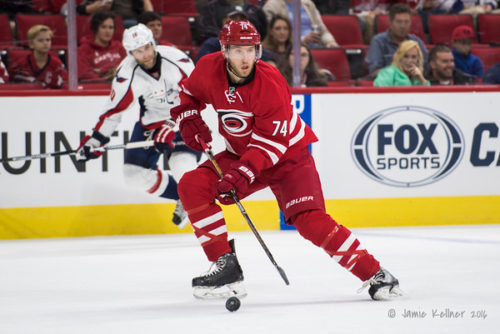Today’s Daily Cup of Joe offers a couple subtle but significant changes in the Hurricanes from a few different categories.
1) Net front friendly
The Hurricanes power play has improved significantly over the past couple years. No doubt Brind’Amour and the coaching staff deserve some credit. And I think that the primary reason is that the team just has so many more skilled players who legitimately belong on a first power play unit. But another subtle but significant key is the team’s willingness to go to the top of the crease when shots are coming. No longer is this certain players’ jobs on the power play or otherwise. Rather, quite regularly skill players like Aho, Svechnikov and pretty much everyone else will spend time making the goalie’s job difficult and equally importantly just being where goals happen. Certainly, there is an element of buy in and commitment, but I think also significant is an adjustment in approach. Gone are the days when Justin Faulk winding up to fire a howitzer that had an equal chance of sticking in someone’s ear hole as the net. Instead, players make a concerted effort to go with a more controlled wrist shot when teammates are in front. The only time one regularly sees Canes players wind up for big slappers is on the cross ice pass on the power play when usually they are ripping to hit an open chunk of net not shoot through a screen. The control gives a better chance to generate a ‘tippable’ shot, but also significant is the fact that those shots rarely become head hunters or teeth takers. Hockey players are tough and willing to go into harm’s way, but I also think there is an element of reasonable safety and trust (of the shooters) that plays into the team’s willingness to a man to go to the front of the net.
2) Voluntary buy in for two-way play
One trademark of the Carolina Hurricanes under Rod Brind’Amour is the complete buy in to a man in terms of compete level and and effort in terms of two-way play. Even the v1.0 version of Andrei Svechnikov, Martin Necas and Sebastian Aho when he first moved to center that did have some lapses defensively, never saw issues with effort level. Svechnikov’s biggest fault defensively has always been trying a bit too hard to win a battle he was losing by using his stick to try to even things up. Necas’ most common early flaw was quickly getting the wrong place after a wrong read of a situation. And Aho’s early struggles at center were usually of the sorting things out variety and not at all just being slow or lazy to defend. Significant is that even the errors were almost completely devoid of just not being willing or able to work hard enough.
And I actually think that the Canes ‘to a man’ compete level is the key ingredient in the team’s level of consistency over the past couple years. Yes, the team is now good enough to run teams out of games with skill and scoring. But the team’s pace and compete level that shows up every night makes it possible to wait a period of two for the scoring binge to arrive and also makes it possible to still be in games on lesser nights.
Subtle but significant is the how and why for this buy in. NHL coaches have their ways to get more effort out of players who only begrudgingly put it in. Former Canes bench boss Bill Peters referred to allocating ice time based on desirable actions as ‘using the hammer’. While that is one way to increase commitment level or defensive play, that is not at all the approach Brind’Amour has taken. Rather, I think the Hurricanes have the perfect storm to get buy in from everyone. First, the team has been fortunate to get young players like Aho and Svechnikov who are the type of skill players who score enough to at least try to claim some exemptions but instead are coachable, team-first at their core. But I think equally importantly is that some combination of Justin Williams and Rod Brind’Amour convinced this group that this was the best or right way to play, not just because of some requirement for ice time.
I think Williams time as captain was significant in that regard. As a proven veteran, he was the type that could maybe take an exemption or to and defer certain lunch pail type duties to lunch pail type players. Instead, he did the opposite. He chirped constantly in the locker room about the need to go to the net, win battles, etc. and he backed it up every shift with his actions. I also think there is an element of Brind’Amour getting players to buy in in this regard not because of ‘the hammer’ but because it was the path to winning.
3) Patience and space
Another subtle but significant factor in the Canes’ success is the team and market’s ability to let players work through slumps, slow starts or whatever without added pressure. Though I think Brind’Amour has intentionally taken it to another level, I think this actually existed for the most part prior to him taking the reins as head coach. Much of it is the market and media. The historical and current media does not really have the type of aggressive heel that harshly (even if sometimes fairly) critiques players or the team, especially not in the incessant way that can be common in bigger markets. Even the beat reporters who cover the team on a daily basis tend to go out of their way to steer around criticizing the team. The fan base is even more player-friendly even when things are not going well. Scott Darling is the prime example. A large contingent of the team’s fan base embraced and supported Scott Darling to the very end despite the fact that he signed a big contract, showed up not ready physically and never lived up to his contract for more than a game or two in a row before bought out. So outside of the arena, the atmosphere is friendly and light on added pressure.
More significant is Rod Brind’Amour’s handling of players. He legitimately grades on effort and doing things the right way. If and when he has to lay into a player which I do not think happens often, it does not even make the media. He also has a legitimately patient approach to new players and does not go knee jerk on ice time or role if a player is doing the basic work. Here, Dougie Hamilton is the case and point. Few probably remember it now because of how the majority of his time as a Hurricane went, but he actually struggled for half of his first season with the Hurricanes. He did get bumped down to the third pairing for awhile, but Brind’Amour never took him to task publicly nor did he make a big deal about the learning curve. Subtle but maybe most significant is that Brind’Amour does not get bogged down in game to game details with players who are trying to play their way up. The trap of being overly positive when a struggling player has a better game is that it puts the spotlight on a player and maybe makes them feel it more if the next game is a step back. When Svechnikov was learning, Brind’Amour mostly referred to it as such and made it seem like it was part of the normal process. The subtle but significant result is a never too high/never too low approach to players having ups and downs especially during downs that are not effort-related. That environment both internal and external to the team is favorable for new players. On some teams/in some markets, the pressure to step in and produce at a high level is immense and becomes a weight on players trying to find that higher gear.
Though it might not be needed based on his hot start, that can be significant for Frederik Andersen, and it gives Jesperi Kotkaniemi space to just do his thing without mounting pressure. Brind’Amour will do all he can to keep added pressure off him and just give him as much time as he needs to hopefully settle in like Hamilton did.
What say you Canes fans?
1) Do you similarly think the team more consciously chooses wrist shot over slap shot to be net front friendly, or do you think the decrease in big slap shots is just a result of player turnover?
2) Between Brind’Amour, Justin Williams leadership at the point of transition and the players themselves, how would you allocate credit for the Hurricanes work ethic buy in across the roster?
3) Do you similarly see the Hurricanes and its market/media as an advantage especially for new players being able to transition with minimal pressure?
Go Canes!




Well written, Matt.
I think the more relaxed Carolina attitude is the right thing for many players who can’t work with the scrutiny and intensity of markets like Toronto or New York, where players are under constant pressure to not only perform but to set examples, both publicly and privately, of how to be a flawless human being.
Nobody can live up to those expectations.
I just want players to play hard, be good teammates, stay away from violence, and stay out of the penalty box of public opinion.
Don’t engage in socially sensitive issues on media (mass and social). If they make millions I do expect them to give some of it back to the community that funds the teams by donating to charity or cause of their choice.
What they do or say in private, including their political opinions, is none of my business and I don’t want it to be.
That’s pretty much the expectation for all of us working in corporate America nowadays.
On that note, obviously, DeAngelo has been a nice surprise since joining the Canes. I don’t know how many assists he has. He makes his share of turnovers but he sacrifices the body and plays hard, a kid with something to prove. He has made some blunders in the past, but being a kid with money in the bright lights of New York is no easy feat either, we all did some dumb things when younger and those would probably have been bigger if we had more cash and people asking for our autographs and opinions all the time.
So far he has managed to stay out of the box of public opinion. I hope he is proving to be a good and dependable teammate, but I obviously know nothing about that. But I think our coach has the culture to help players in that department and Raleigh is a bit more laid back with their questions and cameras.
All this is another way of saying that the culture has changed. The only way to have success here now is to “do things the right way.” The change started when JW came back and RBA became the head coach; yes, there were a number of players that immediately bought in and wanted this style of play, but it’s now pervasive across the entire lineup.
Hopefully, moving forward, it’s an organism that will reject antibodies that don’t fit in.
This article is spot on. RBA’s fingerprints are all over the 3 year transformation of this team from also-rans to league leaders in most categories.